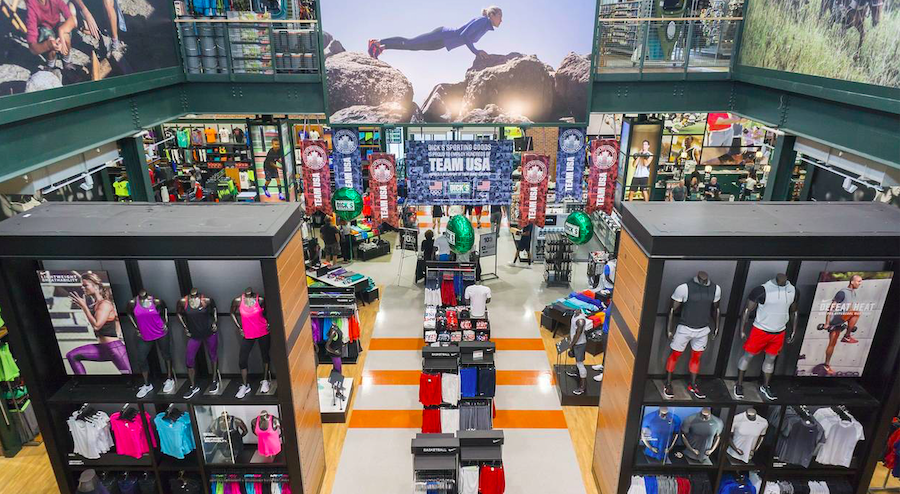Dick’s Sporting Goods reported better-than-expected earnings in the first quarter due to aggressive stock buybacks and same-store sales reaching the high-end of plans with the help of stepped-up inventory investments. Shares, however, slid after tepid guidance was provided for the back half of the year due largely to the potential impact of tariffs.
“We’re uncertain of what’s going to happen with tariffs and what effect they’re going to have on the consumer,” said Ed Stack, CEO, on a conference call with analysts. “Nobody knows and as we said we’re trying to be a bit conservative here because we don’t have enough information about what’s going to happen.”
Shares of Dick’s closed Wednesday at $33.67, down $2.11, or 5.9 percent, on the New York Stock Exchange.
For the current year, Dick’s expects now expects earnings in the range of $3.20 to $3.40, up 5 cents from a range of $3.15 to $3.35 under its previous guidance. In 2018, earnings were $3.24.
The updated guidance is based on an estimated 91.5 million diluted shares outstanding from 95 million as contemplated under its prior earnings guidance due to stock buybacks, offset by interest expense and tariff uncertainty. Including a related increase in interest expense, stock buybacks represented 9 cents per share of the raised guidance, Lee Belitsky, EVP and CFO, said on the call.
The updated guidance also doesn’t include the move on May 10 to raise tariffs on $200 million of goods, mainly impacting the retailer’s hard line’s business, from 10 percent to 25 percent.
Belitsky said on the call, “We’re still working through the impact of this increase with our manufacturing and brand partners, and how this may influence our overall pricing strategy. As a result we have not specifically contemplated this into today’s guidance. Like others we are closely monitoring the situation and are hopeful a trade agreement can be reached.”
Same-store sales are now expected to be slightly positive to an increase of 2 percent for the current year, a slight upward adjustment from flat to an increase of 2 percent under its previous outlook. Comps were down 3.1 percent in 2018. The company still expects to deliver positive consolidated comps beginning in the second quarter.
First-Quarter Earnings Top Analyst Targets
In the first quarter, earnings declined to $57.5 million from $60.1 million but rose on a per share basis to 61 cents from 59 cents due to fewer shares outstanding.
On a non-GAAP basis, net earnings declined 2.8 percent to $58.4 million. Earnings per share on an adjusted basis improved to 62 cents from 59 cents a year ago, reflecting a reduction in average share count to 94.5 million in the latest quarter from 102.2 million a year ago due to stock repurchases. Earnings exceeded Wall Street’s consensus target of 58 cents.
Sales in the quarter increased 0.6 percent to $1.92 billion, topping Wall Street’s average target of $1.9 billion.
Same-store sales in the quarter were flat compared to a decline of 2.5 percent in the year-ago period. The flat comp followed six consecutive negative quarters. Average ticket increased 1 percent while transactions decreased 1 percent.
On the call, Stack said the company is “very enthusiastic about our business” with same-store sales near the high-end of expectations. February comps were down due to cool weather’s impact on spring selling and tough comparisons against the Philadelphia Eagle’s Super Bowl win.
The hunt category continued to show sharp declines in each month due to the retailer’s decision in February 2018 to stop selling semi-automatic rifles and ban firearm sales to anyone under 21 following a mass shooting at a Parkland, FL high school. The steepest decline in the quarter was seen in February on the anniversary of the decision.
Same-store sales turned positive in March and remained positive in April “as we started to see the benefits of our key strategies and investments.” Improvement in March and April was seen across apparel, footwear and team sports.
Particularly paying off was the move announced during Dick’s fourth-quarter conference call to ramp up investments in key growth categories after assessing that overly-lean inventories led to lost sales in the fourth quarter. Stack reiterated that the investments were made in “inventory that for the most part isn’t going to be toxic,” citing basic Nike and Adidas apparel and Wilson A2000 Series baseball gloves that tend to avoid markdown pressures.
The move caused inventories to end up 16 percent at the end of the first quarter, but management is comfortable with those levels. Said Stack, “Our inventory is clean and well positioned. And we’re confident in our ability to continue the sales momentum and delivers positive same-store sales throughout the remainder of the year.”
Athletic Apparel Sees Mid-Single Digit Comp
Among categories, athletic apparel stood out in the quarter with a mid-single digit comp gain. Both Nike and Adidas were called out as healthy sellers.
Under Armour, which was an under-performer at the chain last year as it began selling to Kohl’s, is seeing improvement at Dick’s. Stack said Under Armour’s men’s businesses “is really quite good. So all in all, we’re very pleased with what’s going on with Under Armour.”
Dick’s didn’t provide comp detail on the performance of either footwear or the team sports categories although the flat comps assume they were both likely negative. Stack did state the company was “very pleased with our athletic footwear business.” He said the retailer has “made some real changes to our footwear presentation” and “we continue to be pleased with what’s going on from an athletic footwear standpoint.”
The team sports category faced tough comparisons throughout the quarter against last year’s baseball bat regulation change. Both the headwinds of the bat regulation change as well as the Philadelphia Eagles Super Bowl win aren’t expected to impact second-quarter comp comparisons.
Also helping drive support top-line growth is the installation of “bold merchandise presentations,” called Strike Points, that have driven comps in key categories. HitTrax batting cages have also been rolled out to about 150 doors to a solid reception and will reach another 20 during the second quarter.
Private brands’ comps were positive and continue to perform above the company’s average.
Stack said Dick’s still has a goal to build its private label business to $2 billion annually in sales by growing existing brands and launching new labels. During the first quarter, Calia, the women’s fitness line, expanded its footprint to take over more premium floor space in 80 locations. Calia is also expanding by introducing more premium pricing on higher-quality product, expanding into travel, and further investing in “to the gym and from the gym.”
For fall, Dick’s will launch the DSG athletic apparel line, which essentially replaces its licensed Reebok offering and focuses on a more value-priced point versus Nike and Adidas. Stack referred to the range as “white space for us” that will attract a new customer to Dick’s and a broad launch is being planned. Said Stack, “We’ve been very pleased with the feedback we received from initial focus groups are excited about the upcoming lunch.”
Hunt Category Pulls Down Comps
Meanwhile, the hunt category saw continued weakness and dragged down overall comps by 100 basis points although the declines were less than recent quarters. The category is expected to continue to be negative throughout 2019 due to weak trends across the hunt category.
Dick’s continues to take steps to reduce its exposure to the hunt category. Stack noted that in the third quarter of last year, Dick’s removed hunt from ten underperforming stores and to replaced it “with a more compelling localized assortment.” Comps turned positive at those locations in the fourth quarter and showed further improvement in the first quarter, including positive transactions and merchandise margin rate improvement.
As first revealed during its fourth-quarter conference call, hunt will be removed from another 125 Dick’s stores in the second quarter and similarly replaced by faster-growing categories tailored to each store’s’ local market. Added Stack, “Looking ahead, we will complete a holistic strategic review of our business, including our Field & Stream stores.”
Online Gains Improve Sequentially
E-commerce was again strong in the quarter, rising 15 percent and improving from the 13 percent gain seen in Q118. Online penetration for the first quarter was approximately 13 percent of total sales, compared to approximately 11 percent a year ago.
Lauren Hobart, president, on the call said the website completely redesigned its baseball and softball landing pages, improved the functionality and performance, and launched a new search engine that has “dramatically” improved page load times for search results across both desktop and mobile.
Dick’s also saw significant growth in BOPIS (buy-online, in-store pick-up) with the aid of improved site messaging inventory availability and in-store execution. Ninety percent of BOPIS orders are filled and ready within 30 minutes.
Gross margins in the quarter were flat at 29.35 percent. Merchandise margins increased 20 basis points, which Stack said reflects “a healthy business.” Occupancy expenses also levered but those gains were largely offset by higher shipping and fulfillment costs as a result of strong e-commerce growth, as well as inflationary headwinds driving freight costs. Said Belitsky, “Importantly, while the gross margin rate of our e-commerce business is lower than our stores, we continue to be very pleased with the overall profitability of this channel.”
SG&A on an adjusted basis was 25.3 percent of sales, down 67 basis points from same period last year. Forty of the 67 basis points decline was attributable to expense recognition associated with a change in deferred compensation plans due to the appreciation in the overall equity markets during the first quarter. That expense was fully offset in other expense or income and had no impact on earnings.
Additionally, SG&A includes strategic growth investments at the same time the retailer is on track to achieve 2019 productivity objectives of eliminating approximately $30 million of expenses. Those savings helped offset a portion of the investments.
In the Q&A session, several questions focused on the hunt category, although Dick’s officials wouldn’t comment on further plans besides pulling the category from 125 more doors. Stack told analysts, “We’re doing a complete strategic review of the hunt business, and I would suspect in the near future in the next call or two will give you a sense of exactly what that’s going to be.”
The other main topic was the potential impact of tariffs. Stack said management’s unsure how the consumer will react to “sticker shock” should 25 percent tariffs reaches the broader range of Chinese imports, including apparel and footwear.
In a note, Jim Duffy, at Stifel, wrote, “We see inventory investments and the anniversary of hunt compares improving visibility to comp inflection but tariff uncertainty (including the possible expansion of tariffs to include footwear and apparel) and consumer response clouds the margin picture.”
The investment firm increased its estimates to reflect the Q1 performance, stock repurchases and the slightly improved comp outlook although Stifel’s outlook also contemplates higher costs from tariffs in future quarters. Duffy wrote, “Tariffs are likely to be a headwind, though management stopped short of quantifying expected impacts to the P&L as uncertainty remains around the percent of merchandise impacted as well as vendor and consumer response.”
Photo courtesy Dick’s Sporting Goods
















